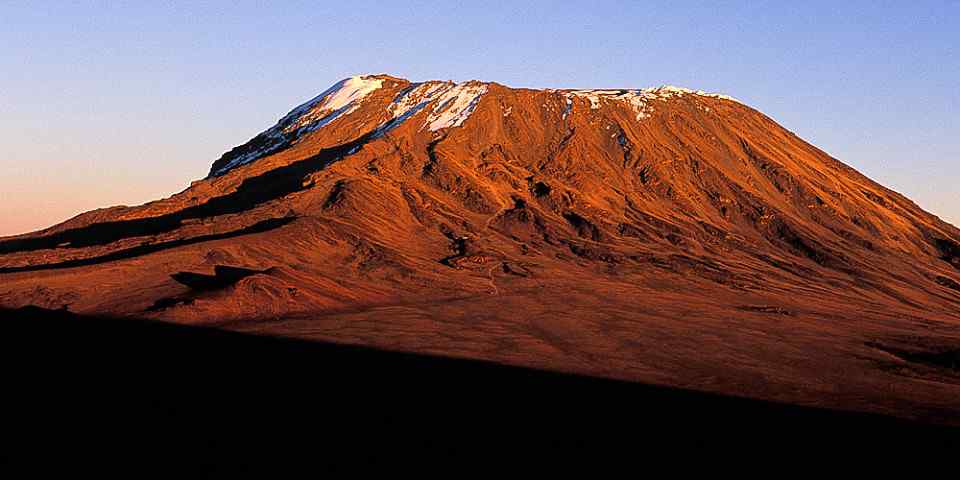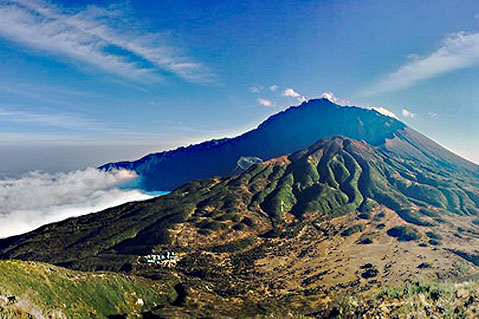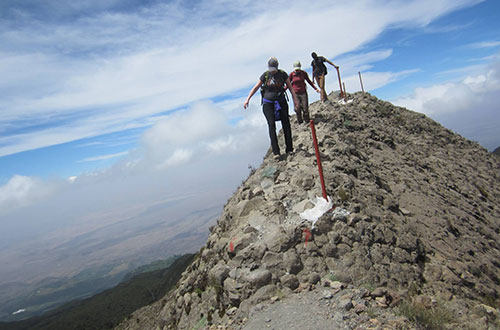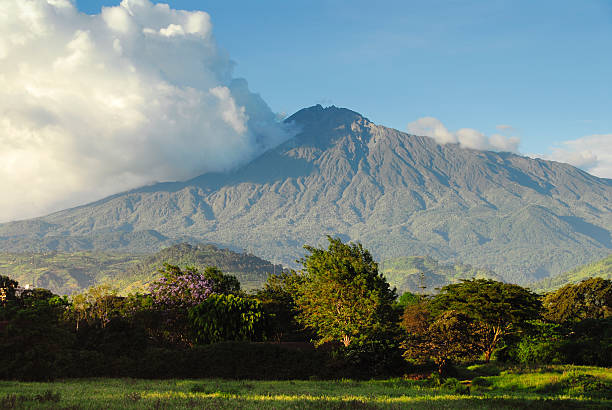Important information
On arrival at Kilimanjaro airport (JRO), will be on time met and transferred to the hotel in Arusha After check in will meet climbing Guide for briefing and gears checking list, ready for next day climbing start.
Solid Hiking Boots- Boots should have high ankle support with a solid Vibram®, or equivalent, sole. Gore Tex®, or other waterproofing, is recommended to have for wet days as well as added insulation. Be sure to break your boots in at least 4 WEEKS prior to departure. Additionally, bring a spare set of laces.
Sun Glasses – Your sun glasses should have 100% UV protection and should reduce glare as well as visible light. The frames should be light weight with a wrap-around design for enhanced grip and staying power. Additionally, side shields are recommended to block peripheral light.
Water/Wind proof Jacket – Your water/windproof jacket is your outer water repellent layer. Gore Tex, seam-sealed is recommended as well as a hood for added warmth.
Water/Wind proof Pants – Your water/wind proof pants will be worn on summit day as well as on rainy afternoons. These pants are essential for warmth and should be Gore Tex lined and have lower leg zips.
Water/Wind proof Mittens or Gloves – These are used for extreme temperatures and primarily worn on summit day. Be sure your gloves or mittens have a wrist cords as well as a reinforced palms to maintain grip during wet conditions. A removable liner is essential for drying, washing, and replacing.
THE ESSENTIALS THINGS TO KEEP IN MIND ABOUT
Look for items that will add less volume to your overall pack. We will be using porters to carry our equipment however they are limited in the amount each can carry. Heavy synthetic materials will be very limiting and could cause issues when packing up for the hike.
CLOTHING & LAYERING:
2 pair’s synthetic warm weather trekking socks – These socks are for trekking in the warmest part of the day since they are made of a Coolmax® fabric. What is Coolmax®? – CoolMax® wicks moisture, dries quickly and breathes well, keeping your feet dry and preventing blisters.
4 pairs heavier synthetic or wool blend socks – Your wool socks are ideal for around camp when the temperature drops as well as on cold mornings. Merino wool is very comfortable and dries quickly with fewer odors than synthetic blends.
2 pairs long underwear top – This will be your base layer for colder mornings, evenings, and days where the temperature drops considerably. The material is lightweight, tight fitting, moisture wicking, and comfortable.
2 pairs long underwear bottom – This will be your bottom base layer for colder mornings, evenings, and days when the temperature drops considerably. The material is lightweight, tight fitting, moisture wicking, and comfortable.
Warm pants – These pants are ideal for evenings around the camp and cold days on the trail. Typically made of lightweight fleece and Wind Pro material, these pants should offer the added warmth in case of cold nights or high winds on the summit.
Fleece Top – This Polartec® 200 weight top will provide added warmth during the evenings as well as on cold morning starts. Please look for fleece material and stay away from cotton sweatshirts. Ideally, this item is worn over the thermal base layer and underneath your water/wind proof jacket.
2 pairs Shorts/Pants for Hiking- These convertible shorts/pants will be what we hike in everyday. They should be of a lightweight, quick drying nylon material. Some come with UPF protection and mosquito protection.
2 pairs long or short sleeve shirts for the trail – Your trekking shirt is what we should wear early in the climb in warmer climates. The shirt is moisture wicking, light weight, and designed for multi-day hikes.
Mid-Layer Top – This shirt is a long sleeve version of the one provided above. The long sleeve trail shirt offers added warmth, more protection from the sun, and an additional layer for evenings and early morning starts.
Warm Hat – This fleece or wool hat is ideal for evenings and will be valuable in the event of cold weather and temperatures on the summit. The hat should be tight fitting with minimal loose ends.
Lightweight Gloves – Fleece gloves are essential. Look for gloves that are Polartec® 200 weight with a leather reinforced palm. For more protection wind proofing is available and will add an extra layer of warmth.
Balaclava – The balaclava provides added warmth on summit day and colder evening. The balaclava should be of synthetic or wool material, light weight, and close fitting.
Sun hat – Your sun hat should be worn at the lower camps and should provide ample coverage for the face. A full brimmed hat is good for added shade and increased sun protection. Additionally, a neck scarf should also be considered to protect the back of the neck”.
Waterproof breathable Gaiters – Your gaiters should be lightweight and durable. Look for Gore Tex lined with the ability to fit over your boots. Velcro or adjustable sides for easy access is recommended.
Down Jacket – 800 fill down jacket will add much need warmth for cold evenings as well as the added layers for summit day. Down is recommended for its compressibility and is comfortable around camp in the early nights on the climb. Patagonia, Mountain Hardware, Marmot, and North Face are brands the guides wear.
THINGS TO KEEP IN MIND FOR CLOTHING
Less is more!!! It is important to bring the essential gear discussed above, but it is more important to refrain from bringing items that are not recommended. Items to stay away from are cotton socks, jeans, multiple pairs of shoes, and heavy sweatshirts. Look for items that are moisture wicking and quick drying fabrics as opposed to cotton fabrics.
ADDITIONAL ITEMS:
Head Lamp- Petzl® and Black Diamond® make several models of small and efficient head lamps. Look for ones that have multiple lighting levels, LED bulbs and uses AAA batteries.
* Please bring at least 3 sets of spare batteries to ensure ample lighting on your summit attempt.
Shoes (Teva Camp, Crocs, Sandals) – These are great for around camp after a long day on the trail. These can also be used for creek crossings that may be higher than the boot. Flip flops work well in warmer climates but are not as effective during cold night
Sun Screen – 30 SPF or higher is recommended as well as water proof and sweat proof. 8 ounces will be plenty and we typically carry one with 45+ SPF for our faces and a 30 SPF for other exposed areas. Banana Boat, REI, Kinesis and All Terrain are good options.
2 wide mount water bottle – A 1 liter water bottle is essential for hydrating at lunch, around the camp, and refilling throughout the day. Stay away from glass and heavy metals and look for lexan® for durability.
Pillow– A Thermarest® pillow that compresses down or folds into itself is ideal. A good benchmark for size and weight are 18 X 14 inches and 9 ounces total.
Dry Bag – A 20 liter + dry bag is great for ensuring your personal items are safe in case of rain. Cameras, wallets, money, and any other valuables can be kept dry at all
Trekking Poles – Collapsible poles are great for steep downhill terrain and assistance up hill. If you have knee problems they reduce the impact on your joints by 20-30%. A nice soft foam grip will help prevent blisters and the poles with an aluminum shaft are durable and light weight.
Camp Towel – the camp towel should be of a polyester nylon blend that dries quickly and compacts tightly in your pack. The large (50 X 27 inches) is a good size and can be used to wash up at the end of the day. Stay away from house or beach towels.
Sleeping bag - A sleeping bag is an insulated covering for a person, essentially a lightweight quilt that can be closed with a zipper to form a tube, which functions as lightweight, portable bedding in situations where a person is sleeping outdoors, especially when climbing Kilimanjaro.









